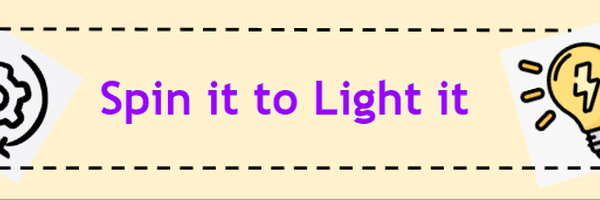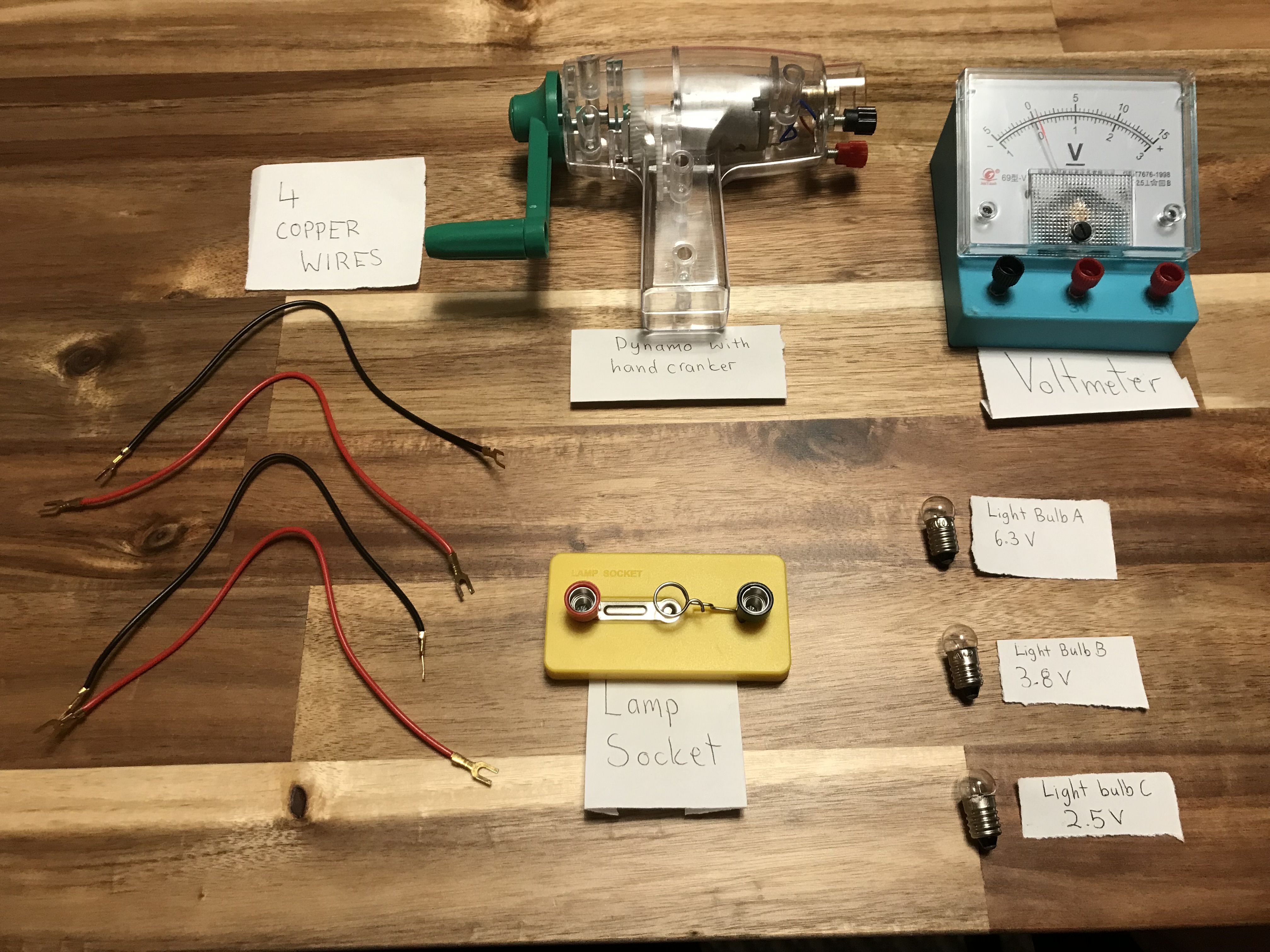Spin it to light it
Grade 5
Presentation
Hypothesis
If the light bulb has a higher voltage, then it would require more force and speed because we need more electricity to light up the light bulb.
Research
Electricity is energy that is used to power up homes and cities.
To light a light bulb, there must be a closed circuit.
A closed circuit needs to have an electricity supply, conductors and a light bulb.
The light bulb will tell you if the circuit is closed or not.
There are two types of circuits: series circuit and parallel circuit
In my experiment, I used a dynamo with a hand cranker as my electricity supply instead of a battery.
When you spin the hand cranker, the magnet in the dynamo will rotate which creates kinetic energy. Using the properties of electromagnetism, it will convert the kinetic energy into electrical energy, also known as electricity, which will flow through the copper wires and light up the light bulb.
Variables
Variables:
| Copper wires | Controlled Variable |
| Light Bulbs | Responsive Variable |
| Spinning Wheel | Controlled Variable |
| Dynamo | Controlled Variable |
| Voltmeter | Controlled Variable |
| Speed and force | Manipulative Variables |
Procedure
Materials needed:
- Three different lightbulbs with different amounts of voltage (Light Bulb A (6.3V), Light Bulb B(3.8V), Light Bulb C(2.5V) but all lightbulbs have the same ampere, 0.3A
- 4 copper wires
- Dynamo with hand cranker and two terminals
- Lamp Socket with two terminals
- Voltmeter with positive and negative terminals
Procedures:
- Connect the red terminal of the dynamo to the positive terminal of the voltmeter using one copper wire
- Connect the black terminal of the dynamo to the negative terminal of the voltmeter using one copper wire
- Connect one terminal of the dynamo to one terminal of the lamp socket using one copper wire
- Connect the other terminal of the dynamo to the other terminal of the lamp socket using one copper wire
- Note: There will be two copper wires on each terminal of the dynamo. This will create a parallel circuit
- Add Light
Bulb C to the lamp socket. You must twist the lightbulb until it tightens and the bottom touches the metal plate.
- Spin the hand cranker that is on the dynamo in a clockwise direction
- Spin the hand cranker until the voltmeter reads 1 volt
- Observe the brightness of the light bulb and record your observations
- Spin the hand cranker until the voltmeter reads 2 volts
- Observe the brightness of the light bulb and record your observations
- Spin the hand cranker until the voltmeter reads 3 volts
- Observe the brightness of the light bulb and record your observations
- Repeat steps 6 to 13 with Light Bulb B
- Repeat steps 6 to 13 with Light Bulb A
- Perform your analysis by comparing your observations on the brightness of Light Bulb A, B and C
- Form your conclusion
Observations
Light Bulb C (2.5V)
- When I spun the hand cranker until the reading on the voltmeter said 1 volt, Light Bulb C was dim
- When I spun the hand cranker faster until the reading said 2 volts on the voltmeter, the lightbulb was brighter
- Then, I spun the hand cranker even faster until the reading on the voltmeter said 3 volts, the lightbulb was very bright
Light Bulb B (3.8V)
- When I spun the hand cranker until the reading on the voltmeter said 1 volt, Light Bulb B was very dim
- When I spun the hand cranker faster until the reading said 2 volts on the voltmeter, the lightbulb was dim
- Then, I spun the hand cranker even faster until the reading on the voltmeter said 3 volts, the lightbulb was very bright but it was not as bright as Light Bulb C
Light Bulb A (6.3V)
- When I spun the hand cranker until the reading on the voltmeter said 1 volt, Light Bulb A almost had no light
- When I spun the hand cranker faster until the reading said 2 volts on the voltmeter, the lightbulb was very dim
- Then, I spun the hand cranker even faster until the reading on the voltmeter said 3 volts, the lightbulb was dim
Analysis
-
In order to get a higher voltage, I need to spin the hand cranker faster
-
When I spun the hand cranker until the reading on the voltmeter said 3 volts, Light Bulb B was not as bright as Light Bulb C because Light Bulb B is with a higher voltage compared to Light Bulb C (3.8V vs 2.5V) and 3 volts is not enough for Light Bulb B to light up the brightest because it requires 3.8V for that
-
At 3 volts, Light Bulb A was the least bright because it requires the highest voltage (6.3V vs 3.8V vs 2.5V) to light the brightest
-
Even if there is not enough voltage flowing, a light bulb can still light up, but it will not be at its brightest just like Light Bulb C
Conclusion
The higher the bulb's voltage, the faster I need to spin the hand cranker using more energy so that there is enough electricity to light up the light bulb the brightest.
Application
Concept Application
In a bike-spinning gym, we can apply this concept as an alternative source of electricity to light the gym up by having light bulbs on the bikes. When someone cycles on the bike, it will light the light bulb up using kinetic energy, which will brighten up the gym.
The more people cycle at a higher speed, the brighter the gym will be!
Benefits:
- Save on electricity bills
- Cheaper membership fees
- Attracts more people
Current Applications:
- In a hydropower plant, when the moving water hits the turbine, similar to the dynamo concept, it will create electricity enough to light up a city.
- Dynamo-operated hand-held flashlights
- Light on a bicycle where the light will light up as the cyclist cycles
Sources Of Error
Possible experimental errors are when the circuit is not closed. It might be because:
1. Wires are not connected properly
2. Lightbulb is burned out
3. The motor might not be working
Citations
Citations:
- Khan Academy https://www.khanacademy.org/
- Britannica Kids https://kids.britannica.com/
- Twinkl https://www.twinkl.ca/
- Study.com https://study.com/
- BYJU'S https://byjus.com/
- U.S Energy Information Administration https://www.eia.gov/
- JLab https://education.jlab.org/
- Quizlet https://quizlet.com/gb
- A True Book™ - Physical Science: Electricity and Magnetism By Cody Crane
Acknowledgement
Thank you to my mom and dad, who have helped and supported me through this science project
I also thank Ms.Tang for giving me guidance and feedback to complete this science project
Thank you to my homeroom teacher, Mr.Chris who introduced me to electricity circuits which I then developed further by using dynamos in the circuit
Thank you for taking the time to read through my experiment!


